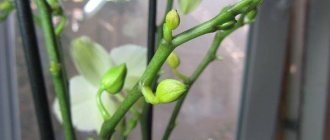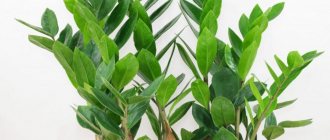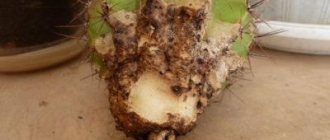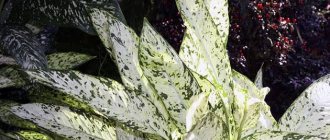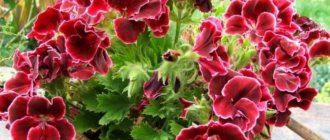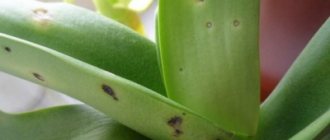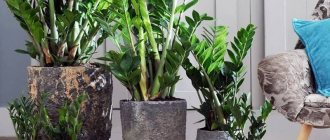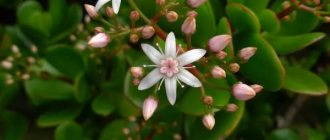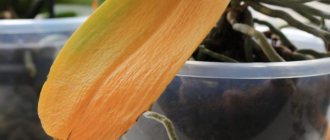Why the dollar tree is crying, and whether it is dangerous, is of interest to everyone who has encountered the phenomenon. Zamioculcas is an evergreen herbaceous plant from the Araceae family. Among indoor flowers it has many relatives, but mostly these are inhabitants of the humid tropics - monstera, anthurium, spathiphyllum, philodendron. For them, the appearance of water droplets at the ends of leaves is not uncommon. But is this normal for the Zamioculcas, an inhabitant of the rocky wastelands?
How to water correctly
Features of the plant
Zamioculcas zamiifolia, also called the dollar tree, contains an unusually high amount of water in its leaves (91%) and tuberous rhizomes (95%).
This ability was developed due to growing in a dry climate. The moisture reserve allows it to survive in low light for four months without water. At the same time, the leaves do not fall until six months - just enough to survive the drought.
Under indoor conditions, such feats are not required from the plant.
Flower growers try to care for and cherish the “green pets” - create a comfortable temperature, water and feed more often. But not everyone takes into account botanical features.
Nature arranges it in such a way that Zamioculcas stores liquid in case of a dry season. However, he still does not come. What should a poor plant do with excess moisture? Removing it through the pores of the leaves is a process called guttation.
If the apartment is dry, for example, during the period of central heating in winter or hot summer, some of the moisture has the opportunity to evaporate.
However, in the off-season, when it is damp both outside and in the apartment, the humidity is increased and droplets of liquid are released instead of evaporation. Therefore, most often the flower cries after watering and before rain. The situation is aggravated by the installation of plastic windows - they disrupt the microcirculation of air between the room and the street.
Tears that appear at the tips of the leaves are a signal to overly responsible gardeners to reduce watering. Moreover, not its intensity, but the intervals between procedures.
Optimal mode
You can’t water it often and a little at a time. On the contrary, the plant must be thoroughly watered until water drips from the bottom hole of the pot. But they do this only 2-3 times a month, and in winter the frequency can be further reduced.
You need to focus on the moisture content of the soil in the flower pot - when it dries to the very bottom, you can carry out the procedure. This can be easily determined with an ordinary pencil or a dry stick.
main reason
There is no need to panic if drops appear on the tips of the leaves. In nature, this phenomenon is called guttation. It occurs when the soil becomes too saturated with water. It gets inside one way or another, and if it accumulates, the plant removes it through the leaf tissue. In this it is helped by special glands - hydathodes.
What to do if the process takes place at home? Stop watering and resume it only after a few weeks.
The regime for Zamioculcas during guttation is once every 10 days and once every 20 (in winter).
But it is better to judge not by time, but by the state of the soil in a specific period. To check, take a pencil or wooden stick and immerse it in the ground for five minutes. If the part that was in the ground turns out to be slightly damp, it is too early to repeat watering.
If you have taken a long break from watering, do not skimp on water. It is poured so that liquid begins to drip from the hole at the bottom of the pot.
Consequences
When overwatered, the plant's trunk and leaves begin to wither. Brown spots appear on the tips. This usually indicates that the roots have become rotten.
To save a tropical flower, remove it from the pot, cut off the damaged roots and burn them with activated carbon. It is necessary to dry the roots and return the zamioculcas to enriched soil with low humidity. You can water it only after a couple of days.
If the leaves are covered with strange holes, this indicates that the plant is cramped in the container and its root system is in a depressed state. Try organizing a transplant and choose a larger pot. Zamioculcas has strong roots, so it is better to choose something made of porcelain or ceramics.
When changing the pot, check the roots at the same time. Rotten ones are removed as quickly as possible.
If the leaves dry out and curl for no apparent reason, you need to check the condition of the roots. Sometimes this happens if the roots rot or become moldy. Try treating them with foundationazole, changing the soil and watering the zamioculcas only occasionally.
But even these measures are unlikely to help: the plant has difficulty restoring the vegetative part if it is grown under artificial conditions.
Other consequences of excessive watering
The secreted juice does not pose a danger to zamioculcas, but it seems to indicate possible problems due to excess moisture.
Why is it important to shed the earthen ball completely, but rarely? — So that the entire root system is involved.
If you water frequently in small doses, the liquid will not reach the lower roots. They will die off as unnecessary, and the upper ones, on the contrary, will begin to rot. As a result, the plant will begin to hurt.
Excess moisture leads to other problems:
- Root rot. It can be easily identified by the leaves and trunk withering and turning yellow at the tips. As a treatment, rotten tubers and roots are removed from the affected specimen. To stop the disease, the cut sites are treated with a disinfectant or sprinkled with ground activated carbon. The old soil must be removed and replanted into new soil. You can purchase ready-made soil for succulents, or prepare it yourself. To do this, sand, leaf and turf soil are mixed in equal proportions. Drainage at the bottom of the pot is required. It is better not to water the flower for the first few days.
- The leaves curl and fall off. Most likely, the root system was attacked by a fungus due to constant waterlogging. The diseased specimen must be dug up, cleaned of the infected soil mixture, and the roots treated with some kind of fungicide. For example, “Maxim”, “Fundazol” or “Benomil”. Replace the soil, make good drainage.
- Holes form on the leaves. There may be several reasons. The first is root rotting due to frequent watering. The second, on the contrary, is associated with a lack of moisture. Third, the soil is depleted and the plant lacks nutrients. To make a diagnosis, zamioculcas must be dug up and the root system checked. If there is rot, it means the flower needs sanitation and replanting. If there are no lesions, then it is most reasonable to replace the soil or replant it in a larger pot and water it more thoroughly, soaking the earthen ball with water to the very bottom.
- Scale insects. These little pests strive to feast on the abundant sap of the plant. They are not difficult to spot, especially when they reach adulthood. They look like upside down shells. But the fight will require patience: large individuals must be removed by hand or with a rag, and the larvae must be destroyed with an insecticide. Actellik is recognized as the optimal drug - it has low toxicity for animals and humans, while being effective. Insecticides are also useful in the fight against other pests: spider mites, aphids and other scourges.
- Anthracnose. The fungus appears as dark spots on greenery. Its cause is a combination of heat and high humidity in the room. For processing, proven means are used: Bordeaux mixture, copper sulfate and colloidal sulfur.
- Powdery mildew, reminiscent of someone scattered flour on the tips of leaves. Treatment of the dollar tree is carried out with the drugs “Skor”, “Topaz” and the like.
Important! Yellowing of leaves is not always a consequence of disease. Their lifespan is limited to six months. Old leaves fall off and new leaves grow. It is quite normal if 5% of the green mass is yellow. But if it’s more than 10%, it’s time to be wary.
Zamioculcas - dollar tree - your assistant for attracting money
Zamioculcas - the dollar tree - is very popular among gardeners, even despite its high cost compared to some other indoor flowers. It has long had a reputation as a plant that attracts good luck into the house and can help its owners get rich with proper care. Believing it or not is a personal matter for everyone, but it’s still worth a try, especially since you don’t need to put in much effort.
The dollar tree looks very solid - long branches with dense and juicy green leaves. Although, in fact, Zamioculcas has no branches - what everyone takes for a stem is a leaf. And the supposedly small leaves are not leaves at all, but feathers. This is such an unusual plant, valued for its unpretentiousness, impressive size and unusual shape.
Zamioculcas blooms white
What is the name of the dollar tree in scientific circles? Its official name is zamioculcas. This plant came to us from South America, where it grows in open areas, creeping along the ground. Under natural conditions, Zamioculcas blooms rarely and only in adulthood, but it does not look very impressive. The flowering of the dollar tree is accompanied by the release of a small light-colored ear with small and unsightly flowers from the plumed leaf.
Dollar Tree: home care
Dollar tree care is minimal. It should be placed on well-lit windowsills, but so that the leaves do not get scorching rays of the sun, especially in hot weather. In summer, you can protect the plant from the heat by covering the windows with thin paper or cloth. The temperature in summer should be maintained at 25 degrees Celsius, and in winter the flower will need 16 degrees.
How to water a dollar tree? From March to October, watering should be carried out as the earthen clod dries out. It is impossible to fill Zamioculcas, as this will lead to rotting of the tubers and leaves. This is one of the few plants that can store water in case of dry weather. It should be watered so that liquid does not stagnate in the pan. It is enough for the water to pass through the entire soil, and it is better to drain the excess.
Fertilizers should be applied twice a month. There is no need to spray; in hot weather, you can sometimes wipe the leaves with a damp cloth. In winter, watering should be very rare, and fertilizing should be stopped altogether. Once during the whole winter you need to arrange a shower for the flower. Some, after purchasing such a valuable specimen, wonder why the dollar tree does not grow. Zamioculcas grows, but very slowly; a rooted leaf, for example, shows its activity only after several months.
How does the dollar tree reproduce?
The dollar tree can be propagated in several ways, but all of them are vegetative. The simplest and fastest method is considered to be the method of dividing an adult bush consisting of several rosettes. You should remove the plant from the pot very carefully so as not to damage the tubers. After dividing the rhizome between shoots, you need to leave all the flowers in the air so that the rhizome dries out a little.
Propagating a dollar tree from cuttings and leaves is a longer process. Both leaves and cuttings must be dried before planting, and the leaf blades will need 1-2 days for this. The leaf is planted in a small pot with light soil made from a mixture of peat and sand. The leaf blade should be a third of its size in the ground. After watering, the plant along with the substrate is covered with a jar to create a greenhouse effect. From time to time the greenhouse needs to be ventilated.
How to properly transplant a dollar tree?
Replanting must be done very carefully
The frequency of Zamioculcas transplants should be no more than once every 2-3 years. Moreover, it is better not to replant the plant in the usual way, but to give preference to transshipment. This is necessary to ensure that the tubers are not damaged. The first transshipment should be made a couple of weeks after purchase in the store. It is better to choose a small and wide pot. With each subsequent transplant, the pot should be slightly wider.
Transplanting a dollar tree is a procedure that requires extreme caution, since if any part of the plant is damaged, sap may get on your hands, and it is poisonous to humans. The best time for transshipment is spring. The bottom of the pot should have a hole for water to drain. The bottom layer in the pot is drainage, after which soil is poured into it. The tubers are not completely immersed in the ground; they should rise slightly above it.
Dollar tree diseases
When growing zamioculcas, it is important to ensure that it is not affected by spider mites, scale insects and aphids. These parasites appear rarely, but unexpectedly, and can move not only from other indoor plants, but also from garden ones. Characteristic signs of aphid infestation are discoloration and curling of leaves. If the leaves of a dollar tree turn yellow, it is most often a sign of improper care or root rot. At the same time, the leaves also begin to actively lose their plumage.
It also happens that droplets of water appear on the leaves of Zamioculcas. Why is the dollar tree crying? This phenomenon occurs extremely rarely; it indicates increased air humidity. Zamioculcas removes excess moisture through the tips of the leaves, and when there is too much water in the soil and air at the same time, dew appears on the leaves.
Dollar Tree: signs and rituals for attracting money
Feng Shui and folk signs determine some rules of behavior when communicating with a flower, as well as methods for conducting special rituals to attract wealth. In order for a plant to be tuned to a positive result, so that it really attracts success and money, you need to be able to negotiate with it. To do this, when replanting and watering, you need to talk to the dollar tree, tell how dear it is to all family members.
To attract money, the tree needs to be “activated”
The next rule is that replanting should be carried out only on a waxing moon, otherwise the plant will quickly dry out and take away all currency savings with it. According to Feng Shui, a dollar tree should be decorated accordingly. You need to hang one or more dollar bills on it, folded into a pyramid, a butterfly, or rolled into a tube. The main thing is that the pyramid on the bill is directed upward.
To attract money using Zamioculcas, you should put a coin in its tray. After each watering, it will spread monetary energy throughout the room. By the way, you can water it with water that has been infused on the coins for about 15-20 minutes. It is better to take not Russian coins, but cents, so that the influx of money is in foreign currency.
Popular signs say that large and succulent leaves of the dollar tree promise large amounts of money in the near future. But if the leaves suddenly began to turn yellow, the plant became sick, and became covered with plaque, then this indicates impending financial problems.
You can believe in signs, or you can ignore them, but the fact remains that the magic of the dollar tree works. This is evidenced by the way it is actively growing in the offices of successful and large enterprises. Many people have already noticed that during a period of growing profits, the flower straightens its plumage and becomes very strong and lush.
If you liked the article, don’t forget to share with your friends:
1magiyadeneg.ru
Ideal conditions
the plant releases liquid when the humidity is high
To reduce the likelihood of disease, zamioculcas needs to create acceptable conditions for growth. First of all, the plant loves light, but it must be protected from direct sunlight.
The optimal location is light partial shade. A guest from Africa needs warmth; after all, it is a tropical plant.
The temperature should not fall below 15°C, and the ideal range is 18-26°C. If the humidity is high, it is advisable to ventilate the room.
Features of the plant
Zamioculcas belongs to the Araceae family, as do Monstera, Philodendron and Calla. But even if they need regular soil irrigation, Zamioculcas does not.
Under natural conditions, this plant chooses tropical regions of Africa. And there, as you know, temperatures are never low, and the humidity level is constantly changing due to climatic instability and seasonal precipitation. In such areas, it is the lush green leaves that help it survive.
At home, you should also not water the soil in which the flower grows too often. Otherwise, its roots will rot and, over time, lose all conductive properties. This will lead to the death of the culture.
Why is Zamioculcas capable of crying?
Zamioculcas zamiifolia is the only representative of the genus of the same name in the araceae family. Although this is a tropical plant accustomed to moisture, drought often occurs in its homeland.
In nature, it grows along the entire southeastern coast of Africa: from Kenya to South Africa. This area is characterized by a clear division of seasons into wet and dry. There are years when not a single drop of rain falls on the ground for 4 or more months.
Zamioculcas learned to survive in these difficult conditions. As a protective reaction, the ability to accumulate large amounts of water in the leaves and thickened rhizomes has been developed. Therefore, when the humidity is high, so that the cells inside the plant do not rupture from excess water, excess liquid is removed through the pores. Drops appear on the leaves, and poetically minded gardeners call them tears.
Consider these phenomena in more detail.
Transpiration is the process of water moving through a plant, its evaporation through the external organs of the plant, such as leaves, stems and flowers. Water is essential for plant life, but only a small portion of the water supplied through the roots is used directly for growth and metabolism. Wikipedia.
The process of transpiration occurs during the daytime, when it is light, dry and warm. In the presence of sunlight, high temperature (20 C - 25 C), the stomata (pores on the leaves of the plant) open, and evaporation occurs through them, water comes out in the form of steam. To compensate for its deficiency, the upper parts of the plant are forced to draw moisture from neighboring tissues, leaves, stems, smoothly sinking lower and lower, gradually reaching the roots of the plant.
Zamioculcas benefits. Is it possible to keep Zamioculcas at home? Gardeners recommend
Plants were created not only for human enjoyment, but also for human peace of mind and well-being. Windows in a house decorated with beautiful and delicate flowers change its entire appearance and create coziness in it. How dull the world would be without flowers! Is it possible to keep Zamioculcas at home? Questions are asked by many lovers of exotic flowers.
The green color of the plant world can improve a person’s mood, as well as his performance.
The lush green leaves of Zamioculcas will contribute to your good state of mind even on gray and cloudy days. This bush will brightly illuminate an ordinary weekday, lift a depressed state of mind, and also bring joy to the patient.
Is it possible to keep Zamioculcas at home? Pros?
Zamioculcas perfectly purifies the air. After all, everyone knows that indoor plants reduce carbon dioxide levels by converting it into oxygen. And in order for flowers to bring the greatest benefit, they need to be placed where you usually sleep or relax. Then your sleep will become serenely sweet and peaceful. And the next morning you will feel cheerful and cheerful. Zamioculcas can also be placed in the room in which your child does his homework. By improving air quality, his attention and performance will increase, which will, in turn, lead to good performance at school.
By the way, doctors have noticed that patients recover faster if there are indoor flowers in their room. Recent studies have shown that patients who were in a room with plants suffered much less pain. They also liked the conditions in which they were kept more than the patients from other wards. Zamioculcas can be placed in a room where a patient is lying, for example, someone suffering from chronic diseases. This will give him vigor and help him become more cheerful. And since Zamioculcas rarely releases its flower, it will not produce a strong and strong floral scent, which is ideal for those who are very sensitive to odors. It will also not cause an allergic reaction, so you can safely give it to a friend who is hypersensitive to allergens.
Actually, it would be very good if everyone had their own green corner. Indoor flowers could be a bright decoration for your home. Well, a correctly selected flower will not only please your eyes, but will also help you regain strength at the end of a hard day.
Types suitable for home use
The genus of Alocasia has approximately 70 original species, as well as human-bred hybrids, but not all can be grown in apartments. Two-meter giants will not physically fit in them. But they look amazing in the foyers of public buildings, in greenhouses and botanical gardens. There is enough space and it is easier to create a suitable microclimate.
Alocasia is widely used in the design of spacious rooms.
Table: Alocasia Sander, dragon and other varieties
| Alocasia species | Character traits |
| Sandera (sanderiana) | The plant has a low stem. Doesn't bloom at home. |
| Amazonian (amazonica) | A low plant (stem no more than 20 cm high), with fairly large leaves (about half a meter) on long petioles (about the same). |
| Low (lowii) | The plant is approximately one meter tall. The leaves below are deep purple. |
| Cucullata | The stem, reaching a height of 50–60 cm, is practically lost against the background of leaves about 1 m long. Their width is also decent - on average 70 cm. The veins on the leaves are almost invisible, but many alocasias have significantly more leaves. Blooms readily indoors. |
| Large-rooted (macrorrhizos), or Indian | A tree-like giant that grows up to 2 m. Unlike most species, it tolerates shade. There is a hybrid variegata, which is approximately three times smaller in size than the “parent”, but has large snow-white spots of irregular shape on the leaves. |
| Odorous (odora) | The only representative of the genus with a pronounced flower aroma. The smell is reminiscent of lilies. It reaches a height of about 1 m. |
| Copper red (cuprea) | The short (up to 10 cm) stem is often completely hidden underground. The flower is very decorative and very poisonous. |
| Black Velvet | Compact plant. The petioles and leaves are covered with short soft fibers. |
| Royal (reginula) | The flower will survive both in bright sun and in the shade. |
| Polly | The leaves are almost vertical. This alocasia blooms quite often. |
| Dragon (draco) | No more than 30 cm in height. Embossed leaves. |
Photo gallery: Alocasia large-rooted, capped, Amazonian Polly and other popular varieties
Alocasia Dragon is distinguished by interesting embossed leaves and a seemingly depressed pattern
Alocasia Polly is most often found among amateur gardeners
Alocasia Black Velvet is not the creation of breeders, although it’s hard to believe
Alocasia copper-red is one of the most decorative
Alocasia fragrant got its name because of the aroma of flowers, similar to the smell of lilies.
Alocasia large-rooted - a plant considered medicinal
Alocasia capulata produces many more leaves at the same time than its relatives
The leaves of Alocasia Lowe have a beautiful purple color on the bottom.
Alocasia Amazonis - the first artificially bred variety
Alocasia Sandera is the basis for many breeding hybrids
Alocasia regal is compact in size.
The role of transpiration in plant life
- overheat protection
- Promotes photosynthesis. Which is best carried out at a temperature of 20-25 C (with the exception of tropical plants); at higher temperatures, chlorophyll is destroyed, as a result of which the process of photosynthesis becomes more difficult.
- Provides continuous movement of water, and with it nutrients (mineral, organic compounds), in plant cells, which contributes to the rapid growth and development of the plant.
- Thanks to its enormous strength, it helps the root system of the plant to work more productively and supply nutrition to the uppermost parts of the plant.
Factors influencing transpiration:
- The intensity of illumination, the higher it is, the higher the temperature of the leaf, the faster and in greater numbers the stomata open, and therefore, the better and more qualitative the process of transpiration is.
- Air humidity, when the air is dry, transpiration occurs much faster.
- Substrate humidity, the drier the substrate, the less water enters the plant, therefore, the transpiration process is inhibited.
- Ambient temperature. At 20-25 C the process goes quickly, with a decrease or increase (destruction of chlorophyll) it slows down.
Guttation (from Latin gutta - “drop”) is the process of removing water in the form of liquid droplets on the surface of a plant by hydathodes. Low lighting and high humidity promote guttation. Guttation is quite common in many tropical rainforest plants... Wikipedia
Guttation occurs at night or in the morning. In the absence of sunlight, the stomata on the leaves of the plant close, since photosynthesis is not possible, and at the same time the process of transpiration stops. However, physiological processes do not stop, the root system of the plant continues to work and absorb moisture, but the evaporation process does not proceed so quickly and the plant no longer requires as much moisture. Therefore, the plant is forced to remove its excess, located in the tissues, with closed stomata, through hydathodes.
Hydathodes are aquatic stomata, devices for the plant to release moisture in the form of droplets (guttation). In the form of shiny droplets, this liquid is observed in a humid atmosphere on the leaves of many plants and is often mistaken for dew. Wikipedia.
There are a lot of hydathodes on the leaf blades of the plant; they do not have the ability to close, they are always open, due to which excess moisture is released through them at night. That is, the reason for the appearance of guttation is the excessive injection of moisture by the roots of the plant and the inability of the plant to evaporate it.
Tropical plant with large and giant leaves
Alocasia is a perennial genus of plants of the araceae family, distributed in areas with a humid tropical climate, from South and Central America to Southeast Asia, Australia and the islands of Oceania.
Adherents of Feng Shui philosophy consider alocasia to be a plant patronized by the moon. Therefore, it is recommended to grow it for those who are hindered by their own incontinence and causeless irritability. The plant adds indulgence, gentleness and tolerance to its owner. Buddhists believe that the flower brings good luck.
Both in natural and at home conditions, the large leaves of alocasia look very impressive.
Basically, flower growers value alocasia for the decorative appearance of its dense, leathery leaves on long, slightly hairy petioles . Young leaves are most often almost round or ovoid; with age, characteristic outlines appear. Many species have scarlet, yellow, silver or white stripes on their emerald green leaf blades.
Representatives of the genus are very diverse. In some alocasias it is extremely difficult to suspect even distant relatives. There are also two-meter tree-like giants, and very small herbaceous plants no more than 30 cm high. But still, some common features can be identified. First of all, it is a tuberous rhizome and a thick fleshy stem, from which milky white juice is released when damaged. Most often the stem is erect, but in some species it curls, resembling a vine.
Alocasia blooms at home quite rarely. Flowers are produced only by plants aged 5–7 years, which have ideal conditions. The inflorescence - a spadix with a spathe - is not considered decorative.
The shape of the Alocasia flower is typical of many tropical plants.
If a peduncle has nevertheless formed and you do not need seeds, experienced flower growers advise cutting it off immediately so as not to unnecessarily deplete the plant. In nature, after flowering, the seeds ripen.
Russia became acquainted with alocasia more than two centuries ago. The first plant (Alocasia large-rooted) was brought especially for the Winter Garden of Catherine the Great.
This flower has quite a lot of nicknames. Due to the shape of the leaves, it is known as “elephant ears” in Asia. Monkeys eat its leaves with pleasure, which is why alocasia is also called “monkey tree.” Amateur flower growers know it as the “shamrock”, because it is very rarely possible to grow more leaves at the same time .
As soon as the alocasia forms a new leaf, the lowest one usually dries out. But for some species, even 3 leaves is a lot; the norm is one.
Drops of water on the leaves - why is alocasia called a barometer?
Alocasia has another interesting feature - it can give a weather forecast. On the eve of rain, large transparent drops appear on the surface of the leaves, like tears. There are especially many of them closer to the tips. Hence such popular names of the flower as “weatherman”, “mourner”, “barometer”. But it is worth saying that you can rely on the “predictions” of alocasia only if you water the plant correctly.
Alocasia is poisonous, but traditional healers in India, China, and Sri Lanka make medicines from it for problems with joints and lungs, trophic ulcers, tumors and open wounds, relieve toothache and even treat cholera.
Why sticky drops appear on Aglaonema leaves
There are plants on the leaves of which sticky droplets, like dew, may appear. Aglaonema is one of them. What is it? We need to figure it out. Only one thought immediately comes to mind: the plant is sick and there are several reasons for this:
- powdery mildew;
- high nitrogen content;
- “false” dew;
- scale insect;
- this is how the flower removes excess liquid.
